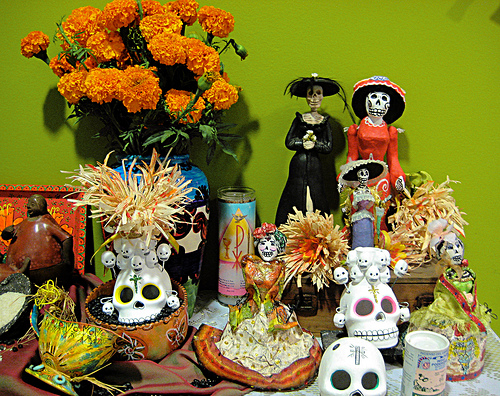Dia De Los Muertos

Dia de Los Muertos, or Day of the Dead, is Latin American holiday celebrated mainly in Mexico, but also throughout the Latin America. The point of the holiday is to gather family members and friends to pray for and recognize deceased ancestors . It takes place on November 1st and 2nd, encompassing, respectively, All Saints’ Day and All Souls’ Day. In Mexico, November 1st is dedicated to deceased young relatives, and November 2nd is dedicated to deceased older relatives. If you live in Mexico or plan to move there, you’ll get to experience one of the most festive holidays of the year.
Family members will often construct altars to honor their ancestors or recently deceased relatives. They decorate them with sugar skulls, marigolds, candles, incense and the favorite foods and drinks of their family members to make it personal to them. Photos of the deceased are often placed on altars. They also visit graves and put gifts on them. They put up such decorations because they think it makes it better for when the souls to come back to earth. That way they will be able to hear the prayers and celebrations in their honor. Families often place toys on children’s graves, and place bottles of tequila or mescal on adults’ graves. They place little treats and candies on everyone’s graves. At home, people often put out ofrendas (offerings), like candied pumpkins, “bread of the dead” or other sugar creations. Families will also leave out pillows and blankets so that the deceased can sleep after their long journey through the dimensions.

Celebrations are done in honor of deceased relatives. These celebrations are usually not sad, but rather festive and even funny. People will talk about silly or entertaining things about their dead relative’s lives. They may also dance with wooden skulls or with shells attached to their costume.
These celebrations date back to the ancient Mexican civilizations, including the Olmec, Zapotec, Mixtec, Aztec and Mayan societies. The idea of Dia de Los Muertos has been practiced for almost 3,000 years! Though the holiday has merged with some Catholic practices, it still retains its ancient routes and practices. Spaniards, like many Europeans, had viewed death as symbolic to the end of life. However, natives viewed death as a different part of life that was just a continutation.

It is also an important day in Spain – Nov 1st is a national holiday and the Spanish visit their families graves en mass.
I really enjoyed this and I will clearly come back soon to read more on your blog.